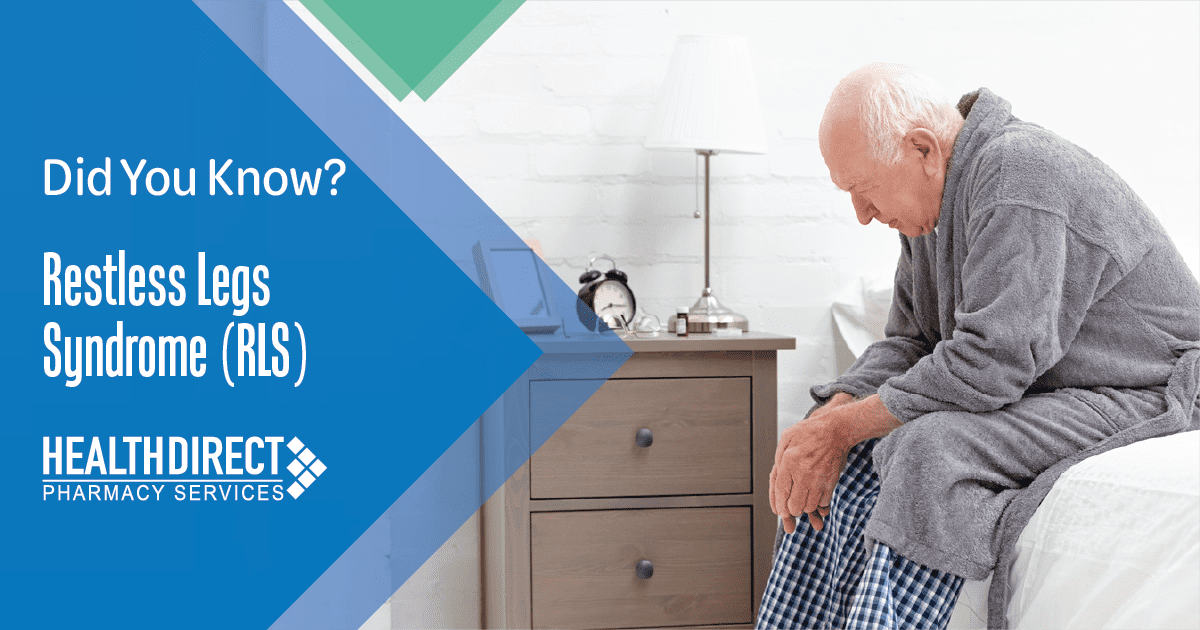What is restless legs syndrome (RLS)?
- RLS is a condition characterized by a nearly irresistible urge to move the legs, usually associated with limb discomfort. Symptoms typically occur at rest, in the evening, and are transiently relieved by movement.1
- RLS can be very disabling and can lead to insomnia, depression, and reduced quality of life.2
- RLS can be intermittent or chronic:
- Intermittent: restless legs symptoms that are troublesome enough to require treatment but occur on average less than twice per week.
- Chronic persistent: restless legs symptoms that are frequent and troublesome enough to require daily treatment, usually occurring at least twice a week and resulting in moderate-severe distress.

How is RLS treated?3
Check iron stores in all patients. Due to an abundance of research demonstrating that patients with RLS have lower than normal iron stores in some regions of the brain and that iron therapy can be beneficial, even if the patient is not anemic or does not have systemic iron deficiency, the updated treatment guidelines for RLS recommend the following:
- – Determine the patient’s iron status (early morning, fasting iron panel: serum ferritin, iron, total iron-binding capacity, and percentage transferrin saturation)
- – If serum ferritin concentration is <=75 µg/L and transferrin saturation is <45%, administer an oral iron preparation (elemental iron 65 mg) with 100 to 200 mg of vitamin C every 1 or 2 days on an empty stomach. (Note that in the presence of inflammation or malignant disease, serum ferritin concentration may be misleadingly high, and thus transferrin saturation <20% may be a more accurate measure of iron deficiency.)
- – Follow up ferritin levels initially after 3-4 months, and then every 3-6 months until the serum ferritin level is >100 µg/L. If there is not an ongoing cause for iron deficiency, oral iron can be stopped. Treatment should be restarted if RLS worsens unless serum ferritin concentration is 300 µg/L or higher.
- NOTE: Consider administering iron at bedtime. Data from nonhuman primate studies has shown that iron is taken up by the brain from the blood at higher rates at night than in the morning.4
Non-pharmacologic interventions:
Non-pharmacological interventions should be attempted for all types of RLS as they may prevent the need for medications or allow for a reduction in dosage in patients where medication treatment is necessary.
These may include:
- Limit or eliminate caffeine and alcohol.Limit or eliminate caffeine and alcohol.
- Reduce symptoms at times of boredom by recommending mental alerting activities such as crossword puzzles.
Check for other co-occurring sleep disorders such as obstructive sleep apnea and ensure they are appropriately managed.
- Many antidepressants and antipsychotics can worsen RLS. Dopamine-blocking antiemetics such as metoclopramide and sedating antihistamines such as diphenhydramine and hydroxyzine can also worsen symptoms. Perform a medication regimen review to see if the patient is on any medications that could be contributing to RLS.
Medications for Treatment:
- Intermittent RLS Intermittent use of the following may be beneficial:
- Carbidopa/Levodopa 25/100 mg or CR 25/100 mg
- These should only be used intermittently as augmentation (drug-induced worsening of RLS) can occur if taken daily.
- Low-potency opioids (codeine, tramadol)
- Benzodiazepines or benzodiazepine agonists such as temazepam, zolpidem, eszopiclone
- (Remember: these are Beers list medications that should be used cautiously due to increased risk of confusion, lethargy, drowsiness, and falls)
- There are no adequate controlled trials of these for RLS. They may be beneficial in patients with another cause of poor sleep such as insomnia associated with psychophysiological factors.
- Chronic Persistent RLS
- First line: alpha-2-delta calcium channel ligands (gabapentin, pregabalin, or gabapentin enacarbil), unless contraindicated.
- Administer 1-2 hours before the usual onset of symptoms.
- Initial recommended doses for patients over the age of 65:
- Gabapentin: 100 mg
- Pregabalin: 50 mg
- Gabapentin enacarbil: 300 mg
- If contraindications to 1st line medications: non-ergot dopamine agonists (pramipexole, ropinirole, or rotigotine patch).
- These medications used to be used as 1st-line treatment for RLS. Due to increasing awareness of the high incidence of dopamine agonist-induced worsening of RLS symptoms and the risk for development of impulse control disorders, these are no longer considered 1st line.
- Administer 1.5-2 hours before symptom onset.
- Initial recommended doses:
- Pramipexole: 0.125 mg once daily
- Ropinirole: 0.25 mg once daily
- Rotigotine patch: 1 mg patch applied once daily
- NOTE: The risk of worsening of symptoms is dose dependent. Careful consideration should be made to not exceed the recommended maximum doses if these are utilized.
- There are two recommended ways to switch from a dopamine agonist to a first line medication5:
- reduce the dopamine agonist dose slowly after the new medication is introduced. There would be an overlap period when the patient is taking 2 medications in this method.
- reduce the initial drug slowly to discontinuation with a drug holiday before the new agent is introduced. Rates of reduction should not exceed 0.25 mg for pramipexole or 0.5 mg for ropinirole every 3 days.
- NOTE: Abrupt discontinuation of a dopamine agonist should be avoided due to increased risk of serious withdrawal effects such as severe RLS, sleep disturbance, and depression.
References:
- American Academy of Sleep Medicine. International Classification of Sleep Disorders. 3rd ed. Darien, IL. American Academy of Sleep Medicine; 2014.
- Earley C, Silber MH. Restless legs syndrome: understanding its consequences and the need for better treatment. Sleep Med. 2010; 11(1):31-37.
- Mayo Clin Proc. n July 2021;96(7):1921-1937 n https://doi.org/10.1016/j.mayocp.2020.12.026
- Hyacinthe C, De Deurwaerdere P, Thiollier T, Li Q, Bezard E, Chorayeb I. Blood withdrawal affects iron store dynamics in primates with consequences on monoaminergic system function. Neuroscience. 2015;290:621-635.
- Wang A, Foster K, Skeba P, Hiranniramol K, Earley CJ, Allen RP. Assessment of change in restless leg syndrome during the acute drug-withdrawal period. Sleep Med. 2018;52:80-87.




